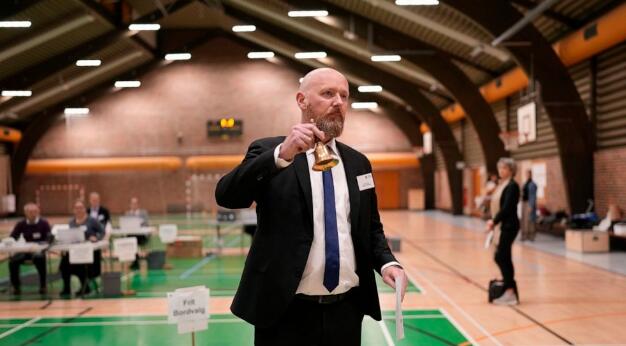
Initial results: Center-left bloc set to win Danish election
COPENHAGEN, Denmark — A full preliminary vote count shows a center-left bloc is set to win Denmark’s election with a one-seat majority in Parliament.
The result puts Prime Minister Mette Fredriksen in a strong position to stay in power. The result is preliminary and based on the assumption that a vote count in Greenland expected early Wednesday will give the autonomous territory’s two seats to the center-left bloc.
Frederiksen was forced to call the election earlier this month amid the fallout from her government’s contentious decision to cull millions of minks as a pandemic response measure. The cull and chilling images of mass graves of minks have haunted Frederiksen since 2020 and eventually led to cracks in the center-left bloc.
THIS IS BREAKING NEWS: Previous version of story is below:
Prime Minister Mette Fredriksen’s Social Democrats won the most votes in Denmark’s election Tuesday but it was unclear whether the center-left bloc that backs her government in Parliament would retain its majority.
With 97% of votes counted, the center-left bloc was just one seat short of a majority, a result which would leave former Prime Minister Lars Løkke Rasmussen as kingmaker. His newly formed centrist party won 9% of the vote, according to official results.
Frederiksen was forced to call the election earlier this month amid the fallout from her government’s contentious decision to cull millions of minks as a pandemic response measure. The cull and chilling images of mass graves of minks have haunted Frederiksen since 2020 and eventually led to cracks in the center-left bloc.
The Social Democrats remained Denmark’s top party with 28% support, but it remained unclear late Tuesday whether the center-left bloc would reach the 90 seats needed for a majority in the 179-seat Parliament. Exit polls suggested it would fall short, but as vote count neared the end, the bloc appeared set to win 89 seats, close enough for a last-minute flip.
A two-time government leader who lost the 2019 election to Frederiksen and abandoned the center-right Liberal party following an internal power struggle, Løkke Rasmussen, wouldn’t say whom he would back as the next prime minister or whether he saw that role for himself.
“I know for sure that Denmark needs a new government, “ he told jubilant supporters in Copenhagen. “Who is going to sit at the end of the table we do not know.”
Denmark may be a small, tranquil country known for having some of the happiest people on Earth, but its politics is filled with intrigue that will be familiar to fans of the fictional Danish TV drama series “Borgen.”
Before the election, Frederiksen, 44, floated the idea of a broader alliance that would also include opposition parties, but was rebuffed by opposition leaders Jakob Ellemann-Jensen of the Liberals and Søren Pape Poulsen of the Conservatives, who both ran as candidates for prime minister in a center-right government.
Denmark’s more than 4 million voters could choose among over 1,000 candidates — the most ever — from 14 parties. Four of the 179 seats in the Danish legislature, Folketinget, are reserved for the Faeroe Islands and Greenland, which are autonomous Danish territories.
Concerns about rising inflation and energy prices linked to Russia’s war in Ukraine and a shortage of nurses in the public health care system were key themes in election campaigns.
“What I feel is important and is a worry to many are the soaring prices, whether it be electricity, bread or gasoline,” said Inge Bjerre Hansen, 82, after casting her vote in Copenhagen. “My son is reducing the number of his visits because it has become expensive to fill the tank (of his car).”
Unlike in previous elections, immigration received little attention. Denmark has some of Europe’s strictest immigration laws and there is broad agreement among the major parties to keep it that way.
That and internal squabbles help explain the collapse of the populist Danish People’s Party, which spearheaded Denmark’s crackdown on immigration two decades ago. Once polling over 20%, the party recorded its worst parliamentary election result since its creation in 1995, with around 3% of the vote, the results showed.
The Danish People’s Party faced competition for nationalist voters from new right-wing parties. Among them are the Denmark Democrats, created in June by former hardline immigration minister Inger Støjberg. In 2021, Støjberg was convicted by the rarely used Impeachment Court for a 2016 order to separate asylum-seeking couples if one of the partners was a minor.
She was eligible to run for office again after serving her 60-day sentence. The official results showed her party getting 8%.
Frederiksen, who became Denmark’s youngest prime minister when she took office at 41 more than three years ago, teamed up with the opposition to hike NATO-member Denmark’s defense spending in the wake of Russia’s invasion of Ukraine. Her steadfast leadership during the COVID-19 pandemic was partly overshadowed by the mink-culling episode.
The decision to slaughter up to 17 million minks to protect humans from a mutation of the coronavirus was taken in haste and without the required legislation in place. It dealt a devastating blow to Danish mink farmers, even though there was no evidence the mutated virus found among some minks was more dangerous than other strains.
A Parliament-appointed commission in June criticized the Social Democratic government’s handling of the issue. That led one of the center-left parties backing Frederiksen in Parliament to threaten a no-confidence vote, which prompted her to call the election earlier this month.
Comments (0)